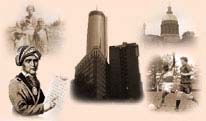Cultivating Homelands
In the KSU Honors Program seminar, exploration of the "Cultivating Homelands" theme focused on farming experiences in Georgia during the early twentieth century. Besides studying a range of oral histories, class members read Raymond Andrews' The Last Radio Baby. We concentrated on ways in which the family's experiences as black sharecroppers were constrained by regional customs and beliefs, yet also reaching toward an enhanced sense of participation in a larger American community-as suggested by neighborhood members' excitement over the power of radio to link them to others around the country during the famous Joe Louis heavyweight fights. Students also carried out their own "Cultivating Homelands" research by doing "Rural Culture Recovery" projects, as outlined below.
Rural Culture Project Honors Seminar, Fall 2000a pdf document (Acrobat Reader needed for viewing)
clicking the link above will provideyou with the instructions for the project
Background on the Rural Recovery Project
By Sarah Robbins
Early in the fall 2000 honors seminar which I taught at Kennesaw State as an overview of
the Keeping and Creating American Communities program, I introduced my students to one of our project themes-Cultivating Homelands-and to the specific local application of that theme that our Georgia team had been studying-Farming Georgia in the Early Twentieth Century. We read Benny and Raymond Andrews' Last Radio Baby, a memoir that includes vivid portraits of the Andrews' family life as mixed-race sharecroppers south of Atlanta. We marveled at Raymond Andrews' gift for crafting striking anecdotes about such experiences as using the family radio to build a sense of connection with a larger world that otherwise seemed far away; attending a segregated small-town school, and observing his parents' ongoing interactions with other sharecroppers but also with the region's more well-to-do residents. We explored the powerful interconnections between Raymond's journal-like writing and Benny's distinctive line drawings.
Integrating our literary study with history, we studied some northwest Georgia farmers' oral histories, originally gathered and edited by KSU history professor Tom Scott. Then we discussed the similarities and differences between the "reporting" of Andrews' memoir and Scott's transcribed interviews. Moving to the web, we spent one of our once-weekly computer lab sessions seeking out websitesa pdf document (Acrobat Reader needed for viewing) that depicted rural life in Georgia during the early twentieth century; then we critiqued those sites-both in terms of their probable historical accuracy and their effectiveness as hybrid presentations using both text and image (like and not like the Andrews book).
While we were doing this reading and discussion, I gave my students their Rural Culture Assignmenta pdf document (Acrobat Reader needed for viewing), asking them to do some research of their own. Since we were just beginning to learn how to do interdisciplinary research, I constructed the assignment to emphasize process more than product-to report on what students learned about the topics they chose but, even more so, on how they investigated and prepared their reports. Some students interviewed relatives about their life experiences during a time when our own area of Georgia was more rural than today. One longtime resident investigated the history of a turn-of-the-century crossroads general storethat is still commemorated in exhibits in what is now a suburban bank.
Two students-Stacie Janecki and Amanda Closs-chose to look closer at places they found out about from our website-searching. Stacie visited a farm about two hours from Atlanta-a combination living museum and family home, with pieces of Georgia's rural past preserved in a cluster of authentic farm buildings but also in the vivid memories of family members who treasure the place's heritage and are working to keep that heritage alive. Amanda, originally attracted to the little town of Euharlee by a community website's information on its covered bridge, wound up becoming close friends with the local museum curator, Miss Taff, whom Amanda came to value as a crucial custodian of local culture. Both Stacie and Amanda later expanded their original Rural Recovery reports for the course's final project assignment, when some students produced "new" work but most revised one of their pieces from earlier in the course. An edited version of Amanda's initial piece is available herea pdf document (Acrobat Reader needed for viewing). Stacie's expanded project, which she prepared for the final major assignment in the course, is available under "Student Projects."


